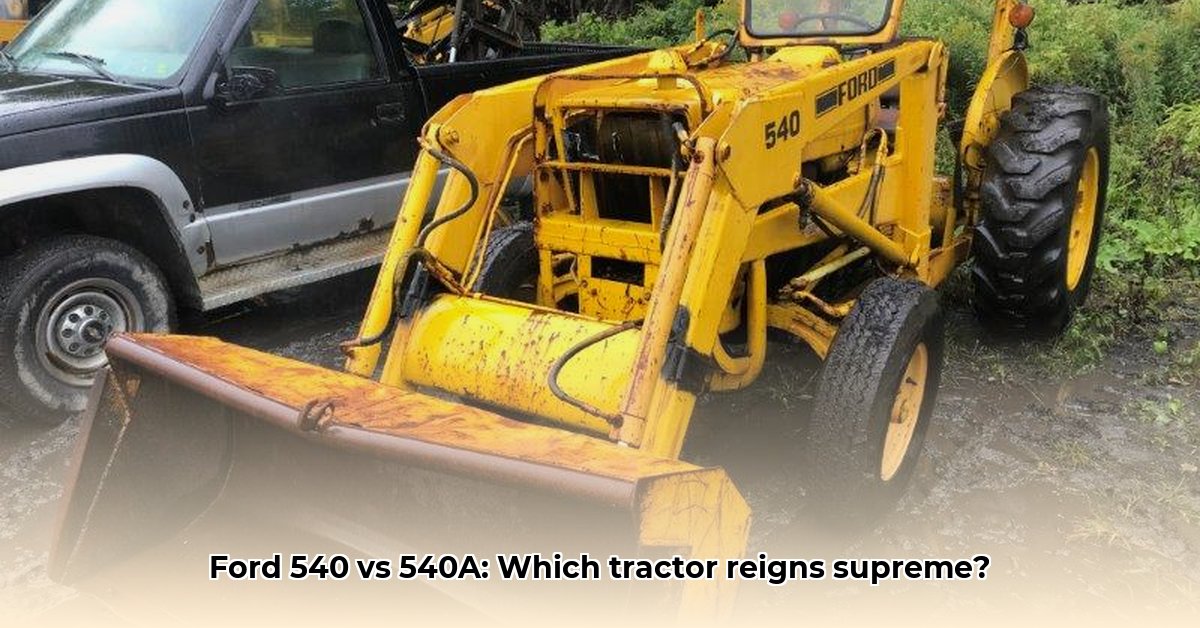
Ford 540 and 540A Tractors: A Comparative Analysis
The Ford 540 and 540A tractors, produced between 1979 and 1984, represent a significant chapter in Ford's agricultural machinery legacy. While visually similar, key differences in engine performance, hydraulics, and transmission systems distinguish these two models. This detailed comparison will illuminate these distinctions, helping potential buyers and enthusiasts make informed decisions. For more information on Ford tractors from this era, see this helpful resource: Ford Tractor Info.
Engine and Performance: Subtle but Significant Differences
Both the Ford 540 and 540A utilized a robust Ford 3.3-liter, three-cylinder diesel engine. However, horsepower outputs differed slightly. The 540 boasted 59.5 gross horsepower, while the 540A produced 59 gross horsepower and a slightly lower 55 net horsepower. This seemingly minor difference likely translated to noticeable variations in performance under heavy load, particularly when pulling heavy implements. Was this difference significant enough to affect daily operation? Farmer testimonials would provide valuable insight.
Steering and Hydraulics: A Modern Upgrade in the 540A
The steering systems represent a key divergence. The Ford 540 featured standard power steering, a reliable but comparatively less refined system. The 540A, however, incorporated a more advanced hydrostatic power steering system, resulting in smoother operation and reduced operator fatigue, especially during maneuvers requiring precision. Beyond steering, the 540A’s hydraulic system offered a significant capacity increase; up to 18 gallons for backhoe applications compared to the 540's 12 gallons (with independent PTO). This improvement directly impacted the tractor's efficiency and capability when using attachments. The 540A also featured an enhanced steering hydraulic flow of 5.5 gallons per minute, versus the 540's 2.74 gallons per minute.
Transmission: Manual vs. Torque Converter
The transmissions further highlight the technological progression from the 540 to the 540A. The 540 employed a 6-speed manual transmission (or an 8-speed option), while the 540A incorporated a more advanced 4-speed torque converter transmission. This shift towards a torque converter provided smoother power delivery and a more comfortable operating experience, similar to the difference between manual and automatic transmissions in automobiles. The final drive systems also differed; the 540 utilized inboard planetary final drives, while the 540A employed a different system – the precise specifications of which are less readily available. This subtly underscores further design refinements in the 540A’s drivetrain.
Weight and Capacity: Reflecting Versatility and Optional Equipment
The Ford 540 consistently weighed approximately 4510 pounds. The 540A, however, exhibited a significantly wider weight range, from 9100 to 11500 pounds. This variation is primarily attributed to the expanded availability of optional equipment such as front-end loaders and backhoes. The increased weight capacity of the 540A underscores its suitability for more demanding tasks.
Additional Features and Options: Enhancing Functionality
Both tractors offered a standard 540 RPM PTO (power take-off) and similar rear lift capacities (approximately 3080 pounds at 24 inches). However, the 540A included an optional differential lock, significantly improving traction in challenging conditions. Both models provided open operator stations, with the crucial safety option of adding a Roll Over Protective Structure (ROPS). The availability of front-end loaders and backhoes for both tractors greatly expanded their versatility.
Detailed Specifications Comparison
| Feature | Ford 540 Tractor | Ford 540A |
|---|---|---|
| Gross Engine Power (hp) | 59.5 | 59 (Gross), 55 (Net) |
| Hydraulic Capacity (gallons) | 12 (Independent PTO) | Up to 18 (Backhoe) |
| Steering System | Standard Power Steering | Hydrostatic Power Steering |
| Transmission | 6-speed Manual, 8-speed Gear | 4-speed Torque Converter |
| Weight (lbs) | 4510 | 9100-11500 |
| Differential Lock | No | Optional |
Choosing Between the Ford 540 and 540A: A Practical Guide
The decision between a Ford 540 and 540A hinges on individual needs and priorities. Both are durable machines, yet their differences warrant careful consideration.
Key Differences and Considerations:
- Axle Configuration: The 540 typically featured an adjustable-width cast steel front axle, offering flexibility; the 540A usually had a fixed-width fabricated axle, potentially providing greater strength. This directly impacts tire size and ground clearance.
- Ground Clearance: The 540 generally offered higher ground clearance, beneficial for uneven terrains common in agricultural settings.
- Parts Availability: Given their age, securing parts for either model may present challenges. Potential repair costs should be incorporated into the budget.
Three Pivotal Points to Consider:
- The 540A's hydrostatic power steering offers superior control and maneuverability compared to the 540's standard power steering.
- The 540A's torque converter transmission provides a smoother, more efficient operating experience than the 540's manual transmission.
- The 540A's significantly higher weight capacity reflects its ability to handle heavier attachments and more demanding tasks.